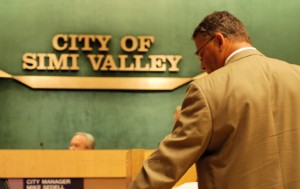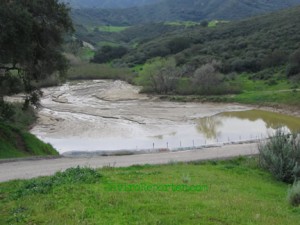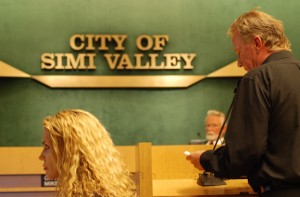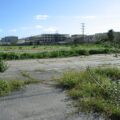
Dozens of residents attended the Simi Valley City Council meeting on November 17 to watch Runkle Canyon environmental presentations by DTSC and the Radiation Rangers, who were assisted by EnviroReporter.com.
Department of Toxic Substances Control’s Norm Riley explained that he had instructed Runkle’s developer to explain dramatic drop in strontium-90 readings in Oct. 17 DTSC letter to KB Home. DTSC also requested that KB Home remove a tarry-like substance from the Runkle Canyon Creek area that lies beneath 11-acre drainage from Boeing’s Santa Susana Field Laboratory.
Riley said that the creek water that flows intermittently into Arroyo Simi is not a “drinking water source” and that the actual tap is the “point of delivery” so contaminant notification rules don’t apply. He did, however, state that DTSC would review the 2007 heavy metals tests of Runkle creek by city of Simi Valley as well as the those done by the Radiation Rangers.

The Radiation Rangers requested a Supplemental EIR that includes the results of these and other tests. Councilmember Steve Sojka agreed, stating “I want to see a Supplemental EIR to see if that water in the creek is safe.”
Mayor Paul Miller concurred. “We would support a supplemental EIR at some point once we get to that time,” he said, to the delight of residents and longtime Rocketdyne activists.
Chromium controversy continues
Controversy continued to swirl around white evaporate found on rocks in Runkle Canyon by the Radiation Rangers that tested high in chromium by the Department of Toxic Substances Control. DTSC’s Norm Riley stated at the meeting that the white evaporate in Runkle Canyon is a naturally-occurring mineral composite, akin to a salt.
In July 2008, a sample of this evaporate that was tested by DTSC was found to have high levels of chromium. However, Riley stated that “chain of custody” was not maintained for this sample. When asked by Councilmember Steven Sojka to comment further on “chain of custody”, Riley said that referred to protocol that ensures that the sample is maintained properly from collection, to storage, to testing. The sample in question was collected by the Rev. John Southwick and Frank Serafine last spring and given in person to Norm Riley the same day at an SSFL workgroup meeting. From that point further, it was presumably in Riley’s possession until it reached DTSC’s lab. To further prove that the white evaporate is naturally-occurring; Riley displayed photos of similar looking substances in other locations.

The white evaporate and high arsenic-containing samples of Runkle Creek water were initially confused by DTSC as indicated on page 5 of DTSC’s October 17th letter. “Based on analyses of several samples of the white crystalline material, DTSC believes this material is a naturally-occurring evaporate salt. Early analytical testing indicated that the material contains different metals; however the metal concentrations were not high enough to pose a threat to human health. It appears that this is the arsenic-containing material that the Radiation Rangers collected in 2007. The material was re-sampled and splits were collected by the City of Simi Valley and the property owner’s consultants. The split samples did not contain elevated arsenic concentrations. A rock coated with white material and collected by the Radiation Rangers was found to contain high levels of chromium, however, no chain of custody was maintained.”
The City and the Rangers tested creek water and adjacent muddy soil, not white evaporate. The white evaporate did not contain high levels of arsenic, the creek water and soil did. Riley was informed of this error and said he would inform the appropriate DTSC staff. Regardless of the misidentification or questions about the chromium-laced rocks that can’t be explained away by chain of custody issues or what ‘water source’ is defined as, the meeting was a milestone in the long-running Runkle Canyon story.
“We are not going to approve any development until we are 100% certain that site is safe to do so,” Mayor Miller said wrapping up the presentations part of the meeting. “And we encourage citizens and continue to find issues to bring them those items to our concern and we will take a look at them. And I think we pretty much infer tonight as a group that we would support a supplemental EIR at some point once we get to that time.”
24 Years of Award-Winning SSFL/Rocketdyne Reporting
June 1998 – June 2022












Recent Comments